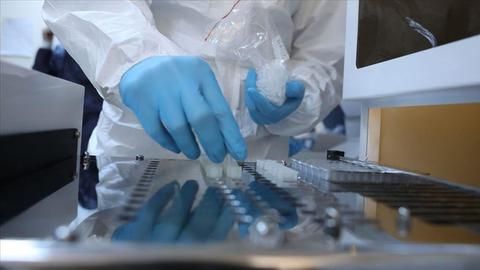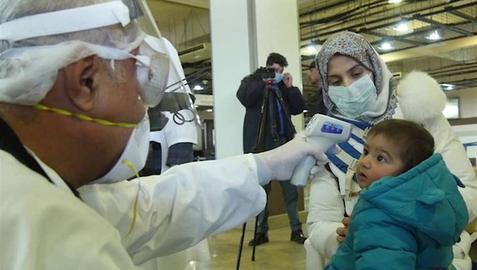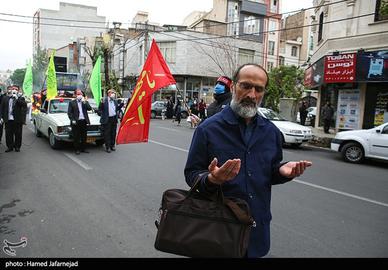The most striking thing about the rolling news of the coronavirus epidemic in Iran is the consistent lying by officials of the Islamic Republic. The lies are obvious to anyone who looks at these statements side by side — lies that have cost people their lives and their livelihoods, and continue to do so.
Iran’s leaders and officials have told many lies over the course of the last few months. This report will examine the four major ones, from officials’ first response to the coronavirus outbreak on January 22 to the end of the first phase of the social distancing policy on April 19.
The First Lie: Iran Does Not Have Tests to Diagnose Coronavirus
On March 27, one of Iran’s deputy health ministers, Alireza Raeesi, said the outbreak of coronavirus in Iran most likely started in the northern province of Gilan after a number of students had returned from China before Wuhan was put under quarantine on January 28. In other words, health ministry officials were saying that coronavirus had reached Iran by the last week of January.
Iranian health officials claim that the very late diagnosis of coronavirus in the country was due to, among other things, a lack of test kits being available. They ignored the fact that, in a statement issued on January 12, the World Health Organization had recommended a CT scan of the lungs as a way of diagnosing coronavirus infections. So the absence of test kits as an excuse constitutes a big lie, told by Iranian officials to justify their failure to carry out a timely detection of the coronavirus outbreak.
Lie Number Two: Iran Developed its Own Diagnostic Techniques Two Months Before the Coronavirus Outbreak
On January 23, Mehdi Gouya, a senior official at the health ministry, announced that Iran had ordered test kits from Germany. On January 27, health ministry spokesman Kianoush Jahanpour confirmed that Iran had received test kits, and on January 29 he reiterated that Iran had the necessary diagnosis equipment and tests. On February 22, health minister Saeed Namaki also announced that Iran had enough test kits. It was after these statements that the lies about the test kits began.
On February 24, Kianoush Jahanpour appeared to have forgotten what he had said almost a month earlier and claimed the World Health Organization was providing countries with test kits depending on the number of that country’s infections. But, on March 21, deputy health minister Alireza Raeesi contradicted Kianoush Jahanpour and two other senior officials at the health ministry, Mehdi Gouya and Hossein Erfani, and claimed that no test kits were available anywhere in the world until February 11, and that it was only after this date that Iran began importing the kits from China.
On April 17, Siamak Samiee, the health ministry’s most senior laboratory official, had a new claim altogether, stating that there were no test kits in Iran before February 9.
It is not easy to decide which of these five senior officials from the health ministry is lying but, at the very least, we can conclude the lies were prevalent, and that officials issued them without difficulty.
However, these lies appear less outrageous in comparison to a claim by Alireza Biglari, head of Iran’s Pasteur Institute, about the testing of coronavirus cases. On April 1, Biglari claimed that “almost two months before coronavirus was identified in Iran, we started designing techniques to diagnose this virus.” On February 20, Iran officially announced the coronavirus outbreak in the country, and yet the Pasteur Institute stated that it had started developing “diagnostic techniques” for the virus two months earlier, on December 21.
There are glaring problems with the claim of this scientific breakthrough. It was only on January 7 that the World Health Organization (WHO) officially announced the outbreak of a new virus in China. On January 12 the genetic sequence of the virus was made public, and the first test kit for coronavirus was developed on January 16. So how could Iran’s Pasteur Institute have begun developing techniques for diagnosing a virus that only became known to the world 17 days later? Are the directors of the Pasteur Institute clairvoyants? Did they know, before anyone else in the world, what kind of virus, with its particular genetic sequence, was going to emerge and ravage the world?
The Third Lie: Until February 16 all Tests Returned Negative
Test kits aside, for approximately an entire month after January 21, Iranian health officials repeatedly claimed that they had tested suspected cases of coronavirus but that no one had tested positive.
On January 29, Kianoush Jahanpour urged the public to have a coronavirus test if they had a high fever and symptoms such as coughing and other severe respiratory problems. On February 16, he reported that all tests of suspected cases had returned negative. Even earlier, on February 5, Alireza Raeesi said that all coronavirus test results had been negative, a claim also made by Saeed Namaki on February 8.
All these claims are false even by other official accounts —according to a statement by Kianoush Jahanpour on April 8, until February 19 the only suspected cases to have been tested were those people who “had traveled to China or had had contact with others whose tests had been positive.” This means that, contrary to the World Health Organization’s guidelines and all the previous claims by the health ministry, all evidence for the existence of coronavirus cases in Iran were intentionally ignored and that any statements about testing before February 19 were false.
The Fourth Lie: We Banned Religious Gatherings From the Start of the Outbreak
The issue of quarantine is another area about which health officials have been contradictory and inconsistent. These contradictions appear to be the result of senior government officials being in opposition to quarantines and the desire of health officials to keep their jobs, even if it meant contradicting what they had said earlier.
On February 23, senior deputy health minister Iraj Harirchi announced that, if necessary, any city contaminated with coronavirus would be shut down and quarantined. But a day later, on February 24, he announced that he was against the idea of quarantines and that they “really belong to the era before World War I.” On March 14, he again changed his rationale and said that quarantine in Iran would not work due to scientific and practical reasons. Then, on March 29, he came closer to telling the truth when he said that there would be no quarantines because the government would be unable to provide people with the necessities to make a lockdown possible.
On February 26, health minister Saeed Namaki said he was against quarantines because they were not necessary, but on February 28, only two days later, he appeared to change his mind and said that, if necessary, some cities would be quarantined for 14 days.
But the most blatant lie about quarantines was told by the government spokesman Mahmoud Vaezi. On March 31, he claimed that immediately after the outbreak, the first phase of social distancing had been implemented across the country, people were being encouraged to stay at home, schools were closed down, and that religious, cultural and sports gatherings had been banned.
Considering that Iran officially announced the country’s coronavirus outbreak on February 19, Vaezi’s claim is completely baseless. Iranian schools were officially closed on March 6 and religious sites and shrines on March 14. Vaezi is also lying about encouraging people to stay home because, on February 25, President Rouhani encouraged people to go to work and mix in society. In fact, he said: “From Saturday, everything is going back to normal.”
Related Coverage:
IranWire reports on Coronavirus Outbreak in Iran
Lies, Misinformation and Makeshift Graves: a Chronology of Coronavirus in Iran
Iranian Online Network Still Peddling Coronavirus Disinformation, 21 April 2020
Coronavirus Pandemic Means Homelessness and Poverty for Refugees in Turkey,
Fact Check: Does Fasting Boost Your Immune System?, 18 April 2020
Fact Check: How Big of a Lie is the Guards' Coronavirus Detector?, 18 April 2020
Iranian Journalists Persecuted for Reporting the Pandemic, 17 April 2020
Fake Coronavirus Detector? Or the Guards' Scientific Achievement?, 16 April 2020
visit the accountability section
In this section of Iran Wire, you can contact the officials and launch your campaign for various problems




























comments